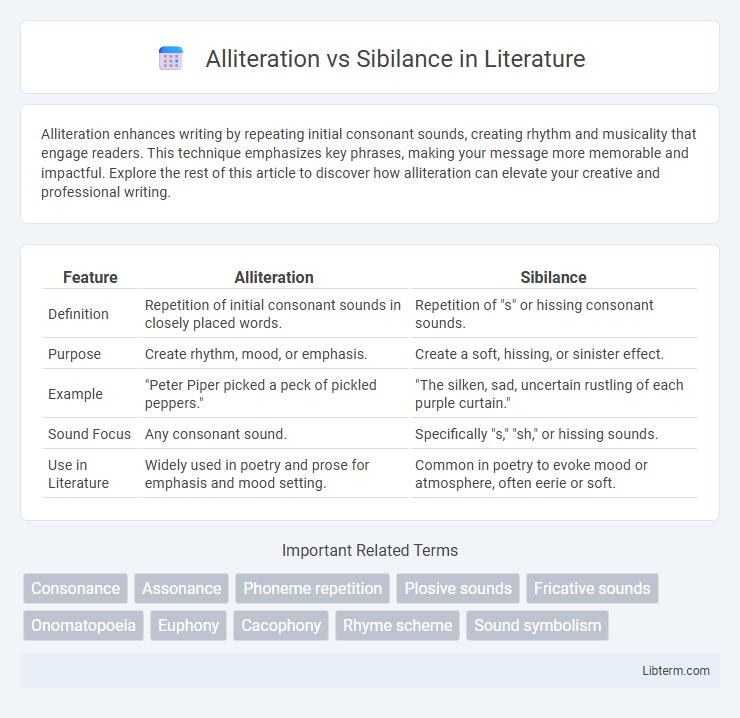Alliteration enhances writing by repeating initial consonant sounds, creating rhythm and musicality that engage readers. This technique emphasizes key phrases, making your message more memorable and impactful. Explore the rest of this article to discover how alliteration can elevate your creative and professional writing.
Table of Comparison
| Feature | Alliteration | Sibilance |
|---|---|---|
| Definition | Repetition of initial consonant sounds in closely placed words. | Repetition of "s" or hissing consonant sounds. |
| Purpose | Create rhythm, mood, or emphasis. | Create a soft, hissing, or sinister effect. |
| Example | "Peter Piper picked a peck of pickled peppers." | "The silken, sad, uncertain rustling of each purple curtain." |
| Sound Focus | Any consonant sound. | Specifically "s," "sh," or hissing sounds. |
| Use in Literature | Widely used in poetry and prose for emphasis and mood setting. | Common in poetry to evoke mood or atmosphere, often eerie or soft. |
Introduction to Alliteration and Sibilance
Alliteration involves the repetition of consonant sounds at the beginning of words in close proximity, enhancing rhythm and emphasis in poetry and prose. Sibilance, a specific type of alliteration, features the repeated use of hissing consonant sounds like "s," "sh," and "z," creating a soft or sinister auditory effect. Both literary devices contribute to mood and tone by engaging the reader's auditory senses through sound patterns.
Defining Alliteration
Alliteration is the repetition of consonant sounds at the beginning of adjacent or closely connected words, often used to create rhythm, mood, or emphasis in poetry and prose. It differs from sibilance, which specifically involves the repetition of hissing sounds like "s," "sh," or "z." While alliteration can encompass a broader range of consonants, sibilance is a subset focused on softer, sibilant sounds that produce a whispering or hissing effect.
Understanding Sibilance
Sibilance is a specific type of alliteration characterized by the repetition of soft consonant sounds like "s," "sh," and "z," creating a hissing or whispering effect in poetry and prose. This repeated sibilant sound often enhances mood, evokes sensory imagery, or emphasizes particular words, making it a powerful stylistic device in literary and rhetorical contexts. Understanding sibilance involves recognizing its ability to influence a text's tone, rhythm, and sonic quality, distinguishing it from broader alliteration which includes any repeated consonant sounds.
Key Differences Between Alliteration and Sibilance
Alliteration involves the repetition of initial consonant sounds in nearby words, enhancing rhythm and mood, while sibilance specifically emphasizes the repetition of soft 's,' 'sh,' or 'ch' sounds to create a hissing effect. Alliteration can encompass a variety of consonant sounds, but sibilance is a distinct subset focused on sibilant consonants. The key difference lies in alliteration's broad use for sonic emphasis versus sibilance's targeted auditory impact to evoke subtle tension or softness.
Common Uses in Poetry and Prose
Alliteration, the repetition of initial consonant sounds, is commonly used in poetry and prose to create rhythm, enhance mood, and emphasize key phrases, often found in tongue twisters and brand slogans. Sibilance, characterized by repeated 's' or hissing sounds, is frequently employed to evoke a soft, sinister, or soothing atmosphere, enhancing sensory imagery and mood. Both devices serve to engage readers by reinforcing themes and emotions through sound patterns, though alliteration tends to energize text while sibilance often adds subtlety and texture.
Impact on Tone and Mood
Alliteration enhances tone and mood by creating rhythm and emphasis through the repetition of initial consonant sounds, often evoking a sense of harmony or intensity. Sibilance specifically replicates soft hissing sounds with repeated 's' or 'sh', which can produce a mood of suspense, eeriness, or sensuality. Both literary devices shape reader perception, with alliteration typically energizing the text, while sibilance subtly manipulates emotional response.
Examples of Alliteration in Literature
Alliteration, the repetition of consonant sounds at the beginning of words, is widely used in literature to create rhythm and emphasis, as seen in Edgar Allan Poe's "The Raven" with the phrase "weak and weary." In contrast, sibilance involves the repetition of hissing sounds like "s" or "sh," producing a softer, whispering effect, evident in Shakespeare's "Sonnet 130" when he writes "sigh, steeped." Classic works employ alliteration to draw attention to key themes, enhance mood, and make passages more memorable.
Examples of Sibilance in Literature
Sibilance, a literary device characterized by the repetition of soft consonant sounds like "s," "sh," and "z," enhances mood and tone through auditory emphasis. Famous examples include Shakespeare's "Sonnet 129," where the hissing sounds in "lustful leads to hell" underscore the poem's sinister themes, and Edgar Allan Poe's "The Raven," which uses sibilance in "silken, sad, uncertain rustling" to create a haunting atmosphere. This technique contrasts with alliteration, which revolves around the repetition of initial consonant sounds regardless of their phonetic quality.
Tips for Writers: Choosing Between Alliteration and Sibilance
Writers should prioritize alliteration when aiming to create rhythmic repetition that emphasizes the initial consonant sounds, especially for dynamic or playful tones. Sibilance, characterized by the repetition of hissing sounds like "s" or "sh," works best for evoking mood, tension, or softness in prose and poetry. Balancing both devices depends on the desired emotional impact and the specific auditory effect intended within the literary context.
Conclusion: Enhancing Writing with Sound Devices
Alliteration and sibilance both enhance writing by emphasizing sound, creating rhythm, and evoking mood, yet they differ in sound focus: alliteration repeats initial consonant sounds across words, while sibilance concentrates on hissing "s" or soft consonant sounds. Effective use of these devices sharpens imagery and strengthens emotional impact, making texts more memorable and engaging. Writers harness alliteration for musicality and sibilance for subtle tension or softness to enrich storytelling and poetic expression.
Alliteration Infographic

 libterm.com
libterm.com